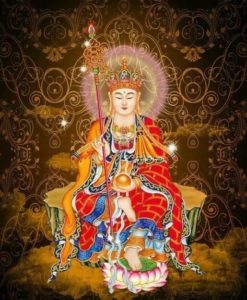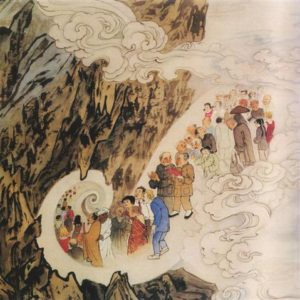地藏王
Earth Treasury King
[Ksitigarbha]

Today, the 30th day of the 7th lunar month [1] celebrates the birthday of Earth Treasury King, the Bodhisattva of the Underworlds [di yu 地狱]. A Buddhist deity in origin, the Earth Treasury King is one of the four principal Bodhisattvas in Mahayana Buddhism, but has been entered into the Daoist pantheon. Also known as the Bodhisattva of the Great Vow, he forfeited the chance to attain Buddhahood, upon seeing the innumerable suffering of all sentient beings in the underworlds. As he could not bear to leave, he remained in the underworlds making a promise:
立弘誓願。願我盡未來劫。應有罪 苦眾生。廣設方便。使令解脫。
-地藏菩薩本願經
I establish a great vow; pledging that I will use up [all] kalpas yet to come [in order] to respond to all sentient beings [who have committed] offences and [are in] suffering. [I will] widely arrange expediencies, [so as] to free and liberate [them].
-Kṣitigarbha Bodhisattva Pūrvapraṇidhāna Sūtra
______________________________________________
The Earth Treasury King’s iconography resembles a celestial being and at-home Bodhisattva [2] [在家菩萨], beautifully adorned, benevolent and solemn as can be clearly seen in the Dun Huang caves and the Long Men Grottoes. He commonly wears a Heavenly Crown [天冠] or Treasure Crown [寶冠] , dignified with a pearl or jade necklace. Following the legend of Jin Qiao Jue [金喬覺], Kim Gyo-gak, a Korean pilgrim who ascended after becoming a Chinese monk under the name Earth Treasury [di zang 地藏] on Mount Jiu Hua [九华山], from the Tang dynasty onwards, his imagery changed into the attire of a monk or bhiksu. This is today’s common depiction, where he appears with a shaven head and a halo [圓頂], wearing a Buddhist crown [毗盧冠], and a kasaya [袈裟 ][3] , holding a precious pearl [寶珠] [4] in the left and a khakkhara [錫杖] [5] in the right. The Bodhisattva of the Earth Treasury is not to be mistaken for Xuan Zang [玄蔵], the monk from the Journey to the West, or Yan Wang [阎王], the King of the Underworld.
The story of the Earth Treasury King strikingly resembles Mu Lian’s [目連] Hungry Ghost Story and, thus, is often confused with the latter. The story of the former is narrated in the Ksitigarbha Bodhisattva Purvapranidhana Sutra [地藏菩薩本願經]:
像法之中。有一婆羅門 女。宿福深厚。眾所欽敬。行住坐臥。諸天衛護。其母信邪。常 輕三寶。。。。。是時聖女廣設方便。勸誘其母。令生正見。而此女母。未全生 信。不久命終。魂神墮在無間地獄。時婆羅門女。知母在世。不 信因果。計當隨業。必生惡趣。遂賣家宅。廣求香華。及諸供具。 於先佛塔寺。大興供養。
During what appeared to be the Dharma-period, there was a Brahman girl, her [stellar] constellation was fortuitous, deep and profound [and she] was admired by the multitudes. [While] walking, standing, sitting and lying, she was protected by all Heavens. Her mother had faith in evil [and] frequently slighted the Three Jewels [6]…..
…..At the time the Sagely Girl arranged expediencies [such as offerings], [and] urged and persuaded [her], to make [her] generate upright views. However, this girl’s mother had not yet thoroughly created faith [in what her daughter said], [when] her life-destiny not long after came to an end [and her] Ethereal Soul and Spirit fell into the indistinguishable underworlds. At the time the Brahman girl was aware that her mother did not believe in Cause & Effect [when] she was alive, and calculated that befittingly in accordance with karma [she] certainly would be born into evilness. Thereupon, she went to the seller’s residence and requested numerous fragrances and florescences [7] and various utensils for offerings. And at first made [those] offerings in the Buddhist stupas and temples on a large scale.
______________________________________________

In the end through all her devotional efforts, her words were heard by the Buddha of the Flower of Meditation and Enlightenment [覺華定自在王],who instructed her to go back home and recite his name so that the whereabouts of her mother would be revealed to her. The Brahman Girl ends up venturing to the Underworldly Realm in a dream where the guardian informs her that through her pious donations and undertakings her mother finally had ascended to the Heavens.
[1] This date will vary in the Gregorian, solar calendar from year to year.
[2] At-home is used in contrast to renounced [chu jia 出家].
[3] A patchwork outer vestment worn by a Buddhist monk.
[4] Cintamani, or wish-fulfilling pearl, is allegedly synonymous with the Philosopher’s stone in Western alchemy.
[5] Buddhist ringed staff.
[6] Buddha, Dharma and Sangha, or Buddha, the Buddhist Laws and the Buddhist community.
[7] Incense and flowers.
______________________________________________
Post-Scriptum: A full translation of the sutra can be found under:
http://www.sinc.sunysb.edu/…/buddh…/ksitigarbha/content.html
